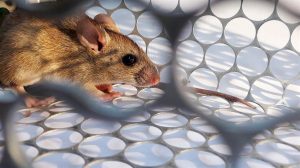Hantaviruses are a type of virus that is transmitted to humans by aerosols from the droppings of some rodents. Hantaviruses are viruses transmitted by rodents, which cause haemorrhagic fever with renal involvement and cardiopulmonary syndrome due to Hantavirus, infections that can be lethal. In both cases, after a contact with the virus through the faeces, saliva or urine of infected rodents, an entry of the virus into the organism through the lungs, from where it spreads to the rest of the body, producing a first phase of general symptoms and high fever, which are not distinguishable from other infections by viruses or bacteria of different types.
Hantaviruses are RNA-like viruses that belong to the so-called “roboviruses”, so called because they are transmitted by rodents. It is a genus of virus that belongs to group C of the family of viruses called Bunyaviridae, which includes other viruses such as Congo hemorrhagic fever and Crimea or Riff Valley fever. Hantaviruses are considered level 4 biosecurity risk viruses.
The Andes virus is the only one that can be transmitted from one person to another (it is thought that cough, saliva, urine and feces, as well as sexual contact).
In order to prevent infections, it is essential to control rodent populations in the urban environment, and to prevent their entry into homes in rural areas, since there is currently no truly effective treatment for people infected with a Hantavirus.
Symptom:
The initial symptoms of this Hantavirus infection begin abruptly and include very severe headache, abdominal and back pain, fever and chills, nausea and blurred vision. Redness of the face and eyes, or a rash may appear.
Later, serious symptoms appear, such as a drop in blood pressure, which can lead to shock with vascular permeability. The characteristic of this type of picture is acute renal failure. It may be accompanied by respiratory distress.
Hemorrhagic fever, not always accompanied by hemorrhages. If they do appear, they can manifest as bleeding on the skin, gastrointestinal bleeding, or bloody sputum.
Supportive therapy is the basis for the treatment of patients with Hantavirus infection. This includes above all the maintenance of the balance of the fluids and ions of the affected (sodium, potassium, chlorine), the level of oxygenation and blood pressure. In addition, we must monitor and treat any additional infection that may appear secondarily, such as pneumonia or urine infections.
Regarding drugs, the only one that has been tested in patients with Hantavirus infection is ribavirin. This drug is effective in cases of infection by Hantaan virus, and it seems that it could be useful also in infections by other Hantaviruses. Corticosteroids have not proven useful in the treatment of Hantavirus infections. Although there are promising studies with the use of monoclonal antibodies, developed after studying the serum of patients who recovered from a Hantavirus infection.
 Prevention is essential to avoid Hantavirus infections.
Prevention is essential to avoid Hantavirus infections.
- Carry out rat extermination campaigns to ensure that there are no rodents that can transmit the viruses.
- In laboratories where rodents are used for experimentation, they must come from controlled sources, and workers must wear appropriate protective equipment.
- In rural areas, the entry of rodents into houses must be avoided, closing cracks and holes through which they can be strained. In addition, it is important to prevent them from entering food stores where they can contaminate food with their droppings.
- If an area is cleaned with the appearance that rodents have passed there, the surfaces should be sprayed with 100% bleach.
- In the event that you are going to camp, try to do it away from weeds or areas of waste or accumulation of garbage, and do not sleep directly on the ground or consume non-potable water.
- If you find a live rodent, you should not touch it, and you must notify the health authorities of your municipality.
- If you come across a death rodent, avoid touching it without gloves, spray the surrounding area and the animal with bleach or bleach and then incinerate or bury it more than 30 cm deep.
- Regarding vaccines, at the moment it is only available for Hantaan and Seoul viruses, but they have a high price. There is no vaccine for the Sin Nombre, Puumala, Dobrava or Andes viruses.
Always take care of your health with a unique and efficient service. Visit Pharmamedic.





